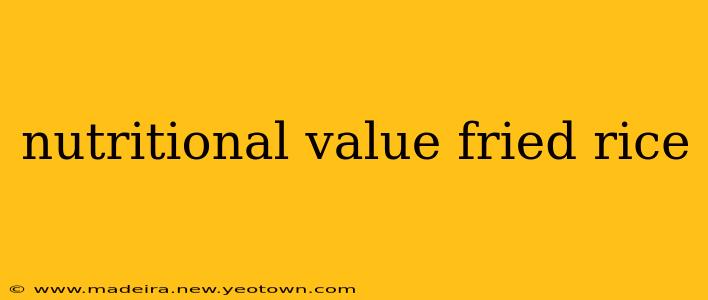Fried rice. The comforting aroma, the satisfying crunch, the versatility… it’s a global favorite. But beyond the deliciousness, what's the real nutritional story behind this iconic dish? Let's delve into the nutritional value of fried rice, exploring both its benefits and drawbacks. This isn’t your average takeout review; we’re going deep into the ingredients and how they impact your health.
Imagine this: you’re at a bustling Asian market, the air thick with the scents of ginger, garlic, and soy sauce. A wok sizzles, transforming simple ingredients into a culinary masterpiece. But that seemingly simple dish holds a complex nutritional profile. The truth is, the nutritional value of fried rice is highly variable, depending entirely on the ingredients used.
What are the main ingredients in fried rice, and how do they contribute to its nutritional value?
The foundation of fried rice is, of course, rice. Usually, this is leftover cooked rice, which contributes carbohydrates for energy. Then come the vegetables – peas, carrots, corn, onions – providing vitamins, minerals, and fiber. Protein sources like eggs, chicken, pork, shrimp, or tofu add essential amino acids. And finally, the flavor bomb: soy sauce, sesame oil, and other seasonings.
However, the cooking method is crucial. The frying process, especially with excessive oil, significantly impacts the overall nutritional value. Let's break down the specifics.
How many calories are in a serving of fried rice?
The calorie count in fried rice can vary wildly, ranging from around 200 to 500 calories per serving, depending on the portion size and ingredients. A serving loaded with meat and plenty of oil will naturally be higher in calories than a vegetarian version made with less oil.
Is fried rice healthy? What are the benefits of eating fried rice?
While not a health food champion, fried rice can be a part of a balanced diet. The benefits depend largely on the ingredients:
- Carbohydrates for Energy: Rice provides carbohydrates, your body's primary energy source.
- Vitamins and Minerals: Vegetables offer a range of essential vitamins and minerals, contributing to overall health.
- Protein for Muscle Building and Repair: The protein sources help build and repair tissues.
- Fiber for Digestion: Vegetables also provide fiber, which aids in digestion and keeps you feeling full.
However, the benefits are significantly diminished by unhealthy cooking methods.
What are the downsides of eating fried rice?
The downsides are mainly linked to the cooking process and specific ingredients:
- High in Fat and Sodium: The frying process often involves a significant amount of oil, leading to high fat content. Soy sauce contributes to the sodium content, which can be a concern for individuals with high blood pressure.
- Low in Fiber (depending on the recipe): While vegetables add fiber, the overall fiber content might be low if vegetables are not abundant.
- Potential for High Glycemic Index: Depending on the type of rice used, fried rice can have a high glycemic index (GI), meaning it can cause a rapid spike in blood sugar levels. This is particularly true if white rice is used.
What are some healthier ways to make fried rice?
Fortunately, you can easily make healthier fried rice choices. Here are some tips:
- Use Brown Rice: Opt for brown rice instead of white rice for added fiber and nutrients.
- Reduce Oil: Use a minimal amount of oil or choose a healthier cooking spray.
- Load Up on Vegetables: Incorporate a wide variety of colorful vegetables to boost the nutritional value and fiber content.
- Choose Lean Protein: Select lean protein sources like chicken breast, fish, or tofu.
- Control Sodium: Use low-sodium soy sauce or other low-sodium alternatives.
Making conscious choices about ingredients and cooking methods can transform fried rice from a guilty pleasure into a nutritious and delicious meal. Remember, moderation and balance are key to a healthy diet!

